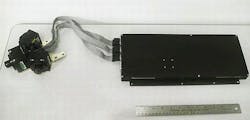Air Force seeks to use existing on-board sensors to enable UAVs to sense and avoid other aircraft
WRIGHT-PATTERSON AFB, Ohio, 21 Oct. 2014. Military and industry researchers are finding ways to use existing sensors aboard manned and unmanned aircraft to enable the platform to sense and avoid other aircraft and operate safely in the National Airspace System (NAS).
Officials of the U.S. Air Force Research Laboratory at Wright-Patterson Air Force Base, Ohio, announced a $23.5 million contract Monday to Defense Research Associates (DRA) Inc. in Beavercreek, Ohio, for the Collision Warning Using Existing Sensors (CUES) program.
At first, DRA experts will seek to perfect their work on the Electro-Optical Small Sense and Avoid System (EO SAA), which uses passive EO sensors and real-time processing to detect cooperative and non-cooperative aircraft nearby.
Related: Aviation authorities to brief industry this fall on UAV sense-and-avoid technologies
The EO SAA is designed to track nearby aircraft, and to alert on those aircraft that appear to be on a collision course. Then DRA experts will seek to commercialize the EO SAA technology by incorporating collision warning capability into fielded aircraft sensor suites without sustaining aircraft modifications, Air Force officials say.
DRA researchers will continue to integrate EO SAA methodologies, technologies, and tools to help the military design and build trustworthy aircraft collision-avoidance systems that require little or no modification to existing aircraft.
DRA's EO SAA work has focused primarily on unmanned aerial vehicles (UAVs) to enable these unmanned aircraft to operate safely with manned aircraft in controlled U.S. air space known as the National Airspace System.
Related: Navy chooses RDRTec to develop common sense-and-avoid radar for Fire Scout and Triton UAVs
Although air traffic controllers on the ground routinely help closely spaced aircraft operate at safe distances, aircraft operating in controlled air space also must have on-board collision-avoidance systems.
UAVs operating in controlled air space are a particular challenge because a communications scheme has not been perfected to enable air traffic controllers to keep in touch with UAVs and give them direction, as they do with manned aircraft via voice and data radios.
DRA's work on the EO SAA technology is among the first steps to fold UAVs into controlled air space by enabling them independently to sense and avoid other aircraft to avoid collisions or near misses.
DRA's EO SAA technology is based on passive visible-light sensors that analyzes a sequence of images, determines which objects move contrary to the background, tracks them, and determines which pose a collision threat. The UAV's ground-based operator then is notified and given a recommended avoidance maneuver.
DRA experts have been developing the EO SAA technology since 2001. The system using field-programmable gate arrays (FPGAs) to 6 million pixels 20 times every second to determine which pixels might represent the intruding aircraft.
These pixels are stabilized to eliminate aircraft motion and then tracked and declared as an aircraft after certain algorithms are satisfied. The intruder data also can help determine a recommended maneuver, DRA officials say.
Related: SRCTec to build ground-based radars to enable UAVs to sense and avoid other aircraft
In early 2007 DRA experts started to shrink the size of their EO SAA technology, developed originally for large- and mid-sized UAVs, to fit on much smaller, tactical UAVs such as the Shadow. The goals were to maintain existing levels of performance while reducing size, weight, and power (SWaP) requirements.
DRA has demonstrated this system in-flight on-board a Textron Systems catapult-launched RQ-7 Shadow UAV, which weighs less than 350 pounds. The demonstrated EO SAA technology demonstrated on the Shadow UAV measured 106 cubic inches, weighed 7.5 pounds, and drew 76 Watts of power.
On the current contract, DRA will do the work in Dayton, Ohio, and should be finished by October 2020. For more information contact DRA online at www.dra-inc.net, or the Air Force Research Lab at www.wpafb.af.mil.

